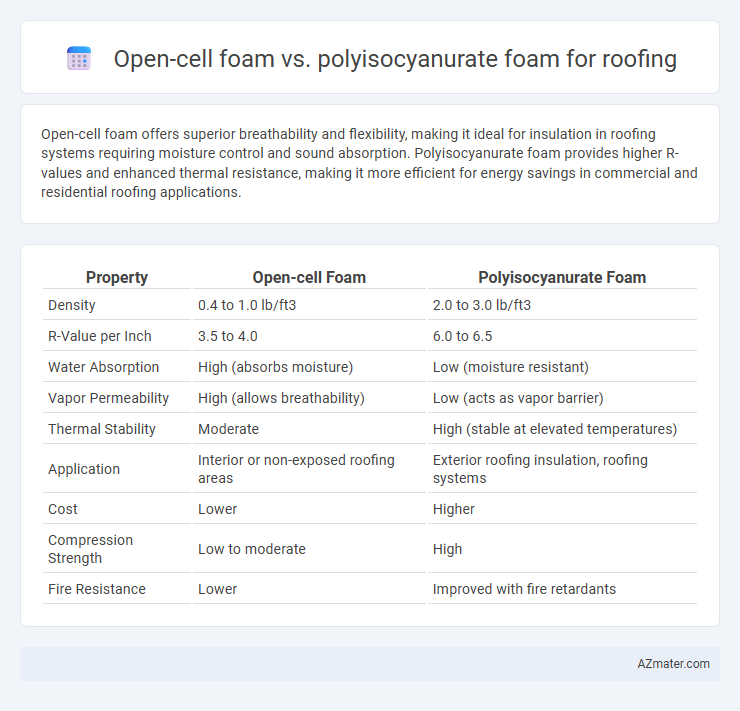Open-cell foam offers superior breathability and flexibility, making it ideal for insulation in roofing systems requiring moisture control and sound absorption. Polyisocyanurate foam provides higher R-values and enhanced thermal resistance, making it more efficient for energy savings in commercial and residential roofing applications.
Table of Comparison
| Property | Open-cell Foam | Polyisocyanurate Foam |
|---|---|---|
| Density | 0.4 to 1.0 lb/ft3 | 2.0 to 3.0 lb/ft3 |
| R-Value per Inch | 3.5 to 4.0 | 6.0 to 6.5 |
| Water Absorption | High (absorbs moisture) | Low (moisture resistant) |
| Vapor Permeability | High (allows breathability) | Low (acts as vapor barrier) |
| Thermal Stability | Moderate | High (stable at elevated temperatures) |
| Application | Interior or non-exposed roofing areas | Exterior roofing insulation, roofing systems |
| Cost | Lower | Higher |
| Compression Strength | Low to moderate | High |
| Fire Resistance | Lower | Improved with fire retardants |
Understanding Roofing Insulation: Open-Cell Foam vs Polyisocyanurate Foam
Open-cell foam offers superior air sealing and flexibility with an R-value around 3.5 per inch, making it ideal for irregular roof structures and soundproofing. Polyisocyanurate foam provides a higher thermal resistance, reaching R-values of 6 to 6.5 per inch, delivering enhanced energy efficiency for flat or commercial roofing applications. Choosing between them depends on factors such as climate, budget, and specific insulation performance requirements.
Composition and Structure: Open-Cell Foam Explained
Open-cell foam for roofing is composed of polyurethane with a lower density, featuring an interconnected cellular structure that allows air to fill the open spaces, enhancing breathability and flexibility. This porous composition contrasts with polyisocyanurate foam, which has a closed-cell structure consisting of dense, rigid cells filled with insulating gases, providing superior thermal resistance. The airy structure of open-cell foam enables better sound absorption and moisture permeability, while polyisocyanurate's tight cellular formation ensures higher R-values and improved moisture resistance for roofing applications.
What Is Polyisocyanurate Foam? Key Characteristics
Polyisocyanurate foam, often referred to as polyiso, is a rigid, closed-cell insulation material widely used in roofing systems for its superior thermal performance and high R-value per inch, typically ranging from 5.6 to 8.0. Key characteristics include excellent moisture resistance, fire retardancy, and structural stability, which contribute to long-term durability and energy efficiency in commercial and residential roofs. Its ability to maintain insulating properties at high temperatures makes polyiso foam a preferred choice for flat and low-slope roofing assemblies.
Thermal Performance: R-Value Comparison
Open-cell foam typically has an R-value of about 3.6 to 3.8 per inch, while polyisocyanurate foam offers a higher R-value of approximately 6 to 6.5 per inch, making it more thermally efficient for roofing insulation. The superior thermal resistance of polyisocyanurate minimizes heat transfer, leading to better energy savings and enhanced building comfort. Choosing polyisocyanurate foam can significantly improve a roof's overall thermal performance compared to open-cell foam.
Moisture Resistance: Which Foam Performs Better?
Polyisocyanurate foam exhibits superior moisture resistance compared to open-cell foam, making it a preferred choice for roofing applications in wet or humid environments. Open-cell foam's porous structure allows moisture absorption, which can lead to reduced insulation performance and potential structural damage over time. Polyisocyanurate's closed-cell composition provides a robust moisture barrier, maintaining thermal efficiency and enhancing roof durability under adverse weather conditions.
Air Sealing and Insulation Efficiency
Open-cell foam offers excellent air sealing properties due to its low density and ability to expand into gaps, reducing air infiltration in roofing systems. Polyisocyanurate foam provides superior insulation efficiency with higher R-values per inch, significantly improving thermal resistance and energy savings. Combining these materials strategically can optimize both airtightness and insulation performance in roofing applications.
Installation Methods and Challenges
Open-cell foam roofing requires spraying onto a clean, dry surface with precise temperature and humidity controls to ensure proper expansion and adhesion, while polyisocyanurate foam is typically installed as rigid panels that must be securely fastened and sealed at seams to prevent thermal bridging and moisture intrusion. Open-cell foam's porous structure demands additional protective coatings to shield against water exposure, posing challenges for consistent application and long-term durability. In contrast, polyisocyanurate panels can be more labor-intensive to fit on irregular roof shapes and require specialized cutting tools, but they provide higher R-values and improved fire resistance compared to open-cell foam.
Cost Analysis: Open-Cell vs Polyisocyanurate for Roofing
Open-cell foam generally costs less upfront, averaging $0.35 to $0.50 per board foot, while polyisocyanurate foam ranges from $0.50 to $0.90 per board foot but offers higher R-values (6 to 7 per inch) compared to open-cell foam's R-value of about 3.5 to 3.6 per inch. Polyisocyanurate's superior thermal resistance reduces energy expenses over time, potentially offsetting its higher initial investment through enhanced insulation efficiency and lower heating and cooling costs. Open-cell foam remains a budget-friendly option for projects prioritizing initial expenditure, though its lower insulation performance can lead to increased energy consumption in the long run.
Longevity and Durability Under Roof Conditions
Open-cell foam offers excellent flexibility and breathability but generally has a shorter lifespan under roofing conditions compared to polyisocyanurate foam. Polyisocyanurate foam provides superior thermal resistance and exhibits greater durability against UV exposure, moisture, and temperature fluctuations, making it more suitable for long-term roofing applications. Longevity studies indicate polyisocyanurate foam can maintain performance for 30+ years, whereas open-cell foam typically lasts 10-15 years when exposed to external elements.
Environmental Impact and Sustainability Considerations
Open-cell foam offers lower Global Warming Potential (GWP) due to its water-blown technology, making it a more environmentally friendly option for roofing insulation compared to polyisocyanurate foam, which often relies on high-GWP blowing agents. Polyisocyanurate foam provides higher R-values per inch, enhancing energy efficiency and reducing overall carbon emissions by minimizing heating and cooling demands. Sustainable roofing choices prioritize materials with lower embodied carbon and improved recyclability, positioning open-cell foam as a greener alternative despite its lower insulation performance.

Infographic: Open-cell foam vs Polyisocyanurate foam for Roofing
 azmater.com
azmater.com